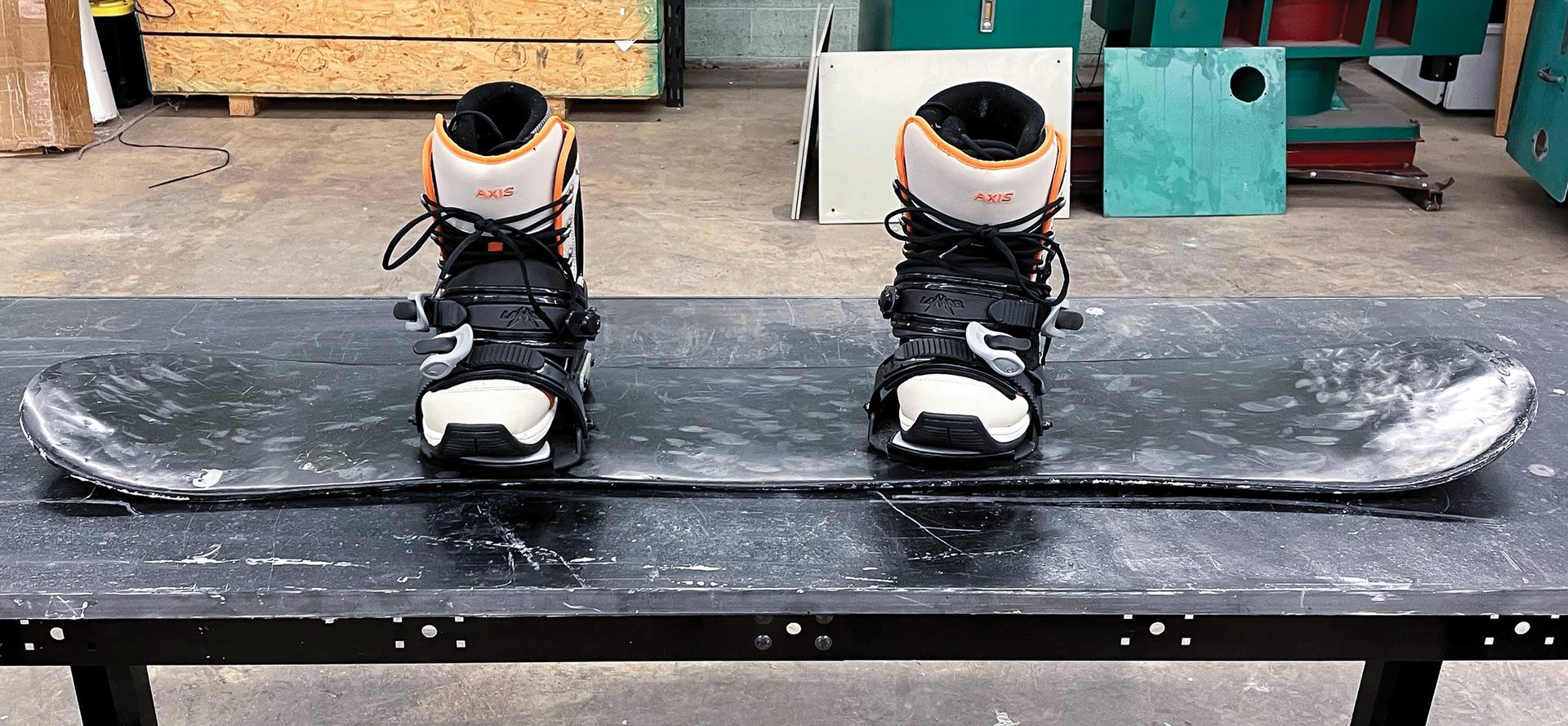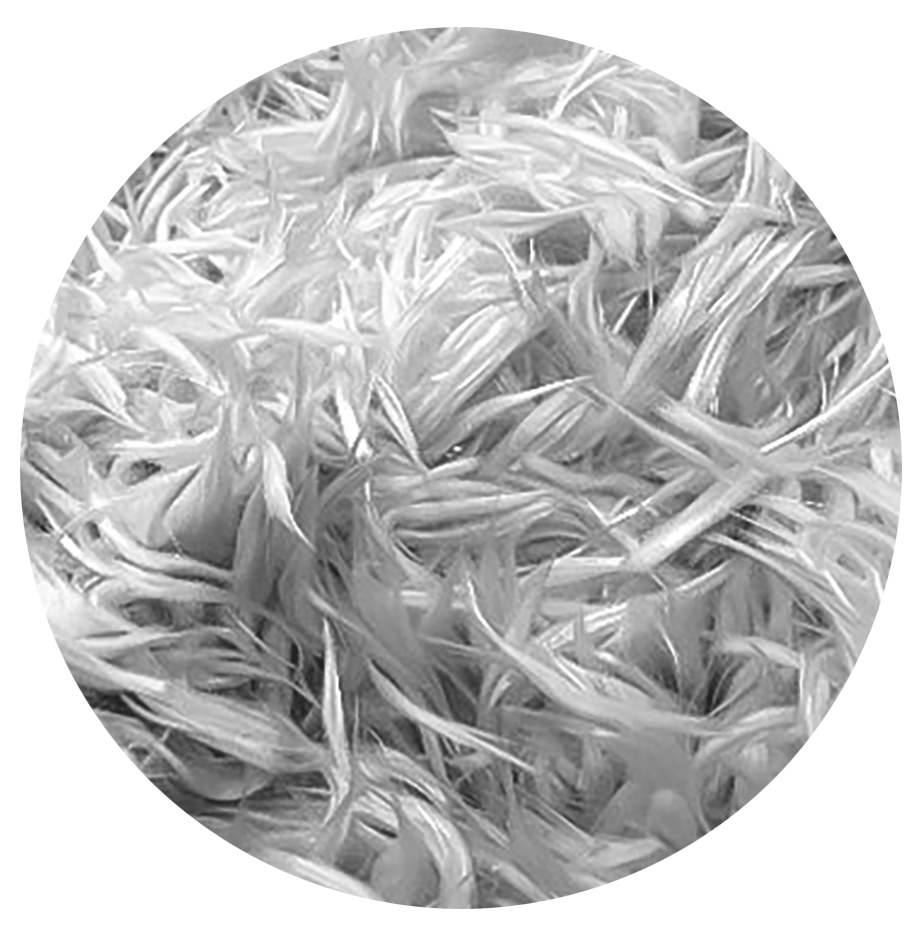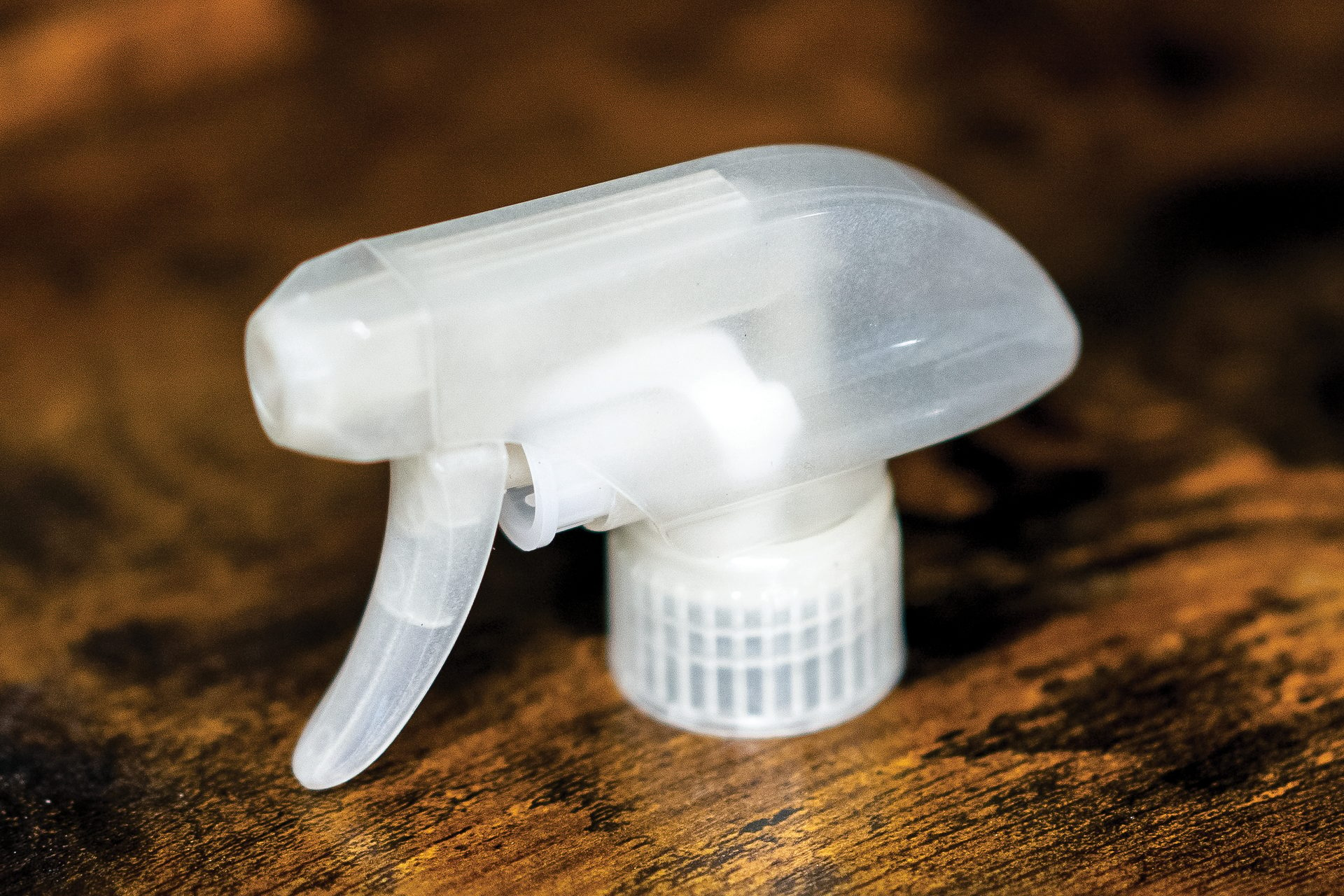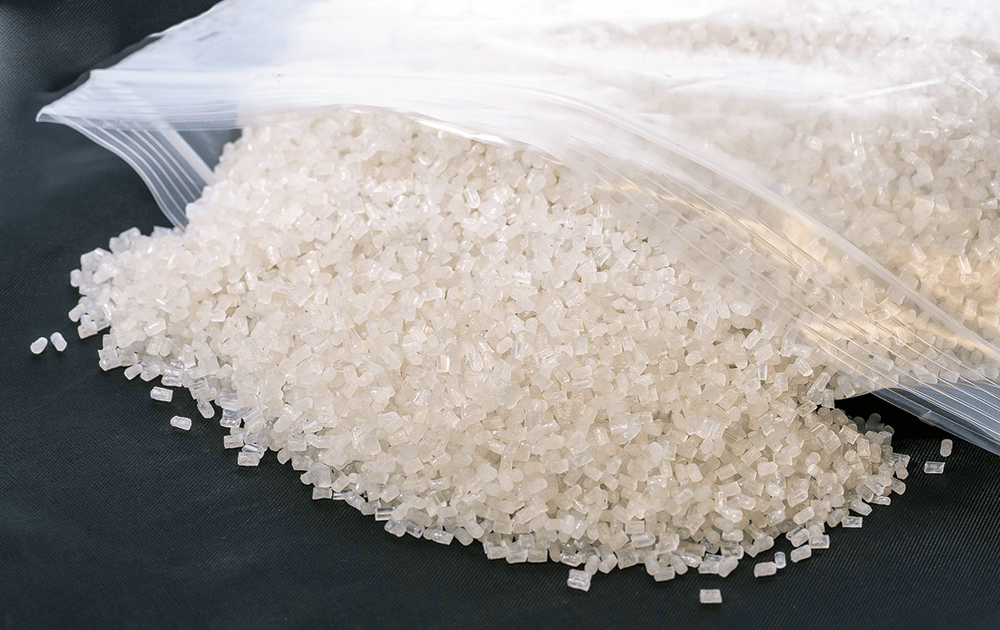
Manufacturing the impossible:
Supporting the development of a circular economy in the composites industry
By David Morgan
bulletin | cover story
Glass fiber-reinforced composites are found in every industry, from marine and wind to automotive and construction. Carbon Rivers’ recent glass-to-glass commercial technology for recovering glass fiber from end-of-life composites poses both advantages and challenges to the composites industry.

To reduce the pileup of wind turbine blades after decommissioning (hero image), Carbon Rivers developed a glass-to-glass commercial technology for recovering the glass fibers (inset).
Credit: Carbon Rivers
Glass fiber-reinforced composites (GFRCs) are ubiquitous in modern life. At any point, one is probably standing within 20 feet of a GFRC component, whether it be in an automobile, boat, wind turbine, or residential composite deck.
Despite their ubiquity, current methods for disposing of GFRCs at the end of their life are not ideal. These composites often end up in landfills, taking up significant amounts of space and wasting the potential to reuse these materials in new products.
Attention to this issue has grown significantly in recent years thanks to social media platforms. Viral photos of wind turbine blades sitting in landfills epitomize the seldom-seen trash created by renewable energy, as well as the frustration and innovation of industries that are attempting real solutions for real problems.
If we wish to continue using GFRCs, stopgap measures are necessary in the short term, such as dumping composites in landfills or using the waste as an alternative fuel for cement kilns. But these options do not provide ecological or even humanitarian responsible solutions to end-of-life composites in the long term.
In 2019, the U.S. Department of Energy provided a Small Business Innovation Research grant (SBIR) to Carbon Rivers (Knoxville, Tenn.) to explore solutions for a composite circular economy, with wind turbine blades being the chief focus. The company, which was founded in 2017 to take advantage of market opportunities in advanced materials, received additional SBIR grants to advance development of a new glass-to-glass (G2G) reclamation process.
Carbon Rivers partnered with LM Wind, Pacificorp, and GE to test the new G2G process. They recovered clean (removal of sizing) and mechanically intact (minimal degradation) glass fibers from end-of-life turbine blades on a pilot process line, while also producing renewable oil and syngas during the recycling process.1
ADVERTISEMENT
Inside Carbon River’s G2G reclamation process
Denver McGrady, product development director at Carbon Rivers, says Carbon Rivers’ G2G reclamation process is “very rewarding” because it is, in many ways, an industry first.
“The G2G process has huge potential to be a sustainable solution for an age-old market,” he says.
The G2G reclamation process begins with a mechanical downsizing (shredding) step. This step includes a mobile track system industrial grinder that can provide a throughput of at least 50 mT per day, which is equivalent to seven and a half GE 37 blades per day. The shredded material can then be screened to determine which will undergo further processing for glass fiber recovery and which will be pulverized as an alternative fuel for cement kilns, which has a comparable BTU to coal.2
The second step in the process is the actual glass fiber recovery from the low-heat thermal process, which cracks the polymer into light and heavy hydrocarbons. The light hydrocarbons recirculate into the system for net positive energy, displacing the need for natural gas, and the heavy hydrocarbons are condensed into a tank, which is captured as renewable polymer oil. The oil can be fractionated to certain points in the stack, including everything from a sulfur-free red diesel to a heavy bitumen.
The amount of polymer crude oil is a happy surprise, as the process initially focused on glass fiber recovery. Initial analysis demonstrated that the oil can be fractionated off the stack for next life cycle petrochemical production or aviation and marine fuel.
The recovered glass fiber is then cleaned, strengthened, and prepared to be turned into new products, for example, processed into nonwoven mats or compounded with various polymers to form thermoplastic pellets. This aspect of the process requires careful oversight to ensure the recovered glass fiber (rGF) material is prepped and tested in accordance with customers’ production part approval processes (PPAPs), which validate materials for use in commercial supply chains.
Each sector of the composite industry has its own product development and validation process. However, most of this testing is done at Carbon Rivers, and then the test data and materials are provided to the OEM / Tier suppliers for final testing and validation. The process is streamlined because Carbon Rivers receives the mechanical values that are necessary from the procurement officers and then sends off the rGF intermediates based on the product specifications.
The entire process encompassing mechanical, thermal, and chemical aspects is a carbon-negative process because the glass fiber, syngas, and oil all offset any embodied energy and greenhouse gas emissions used in the recovery process. These products go back downstream as materials for new components or applications, thus gaining a second life and providing the composites industry with a sustainable, circular economy.
Bowie Benson, co-founder and CEO of Carbon Rivers, has been involved in the process from the beginning. He says, “Doing the impossible, or just plain difficult, is just another day at Carbon Rivers, which is leading the industry in creating closed-loop, full-scope composite waste material solutions. Still, as great as our technology is, it is still second to our most disruptive element: our team. There is a great deal of work to be done, and we are happy to take on the challenge.”

Figure 1. rGF layup for a prototype snowboard.
Credit: Carbon Rivers
The far-reaching opportunities for recycled glass fibers
The opportunities for repurposing glass fibers reclaimed from wind blades, marine vessels, automotive parts, and other GFRC products are far reaching. Many have seen the bike shelters and sea wall breaks made using rGF reinforcements, but more recreational applications are on the horizon, such as snowboards (Figure 1), pickleball racquets, and even recycled composite materials for water park designs.
Of course, there are a variety of sustainable avenues to repurpose end-of-life composites, but Carbon Rivers focuses on downstream applications that are both economical and practical. For example, rGF reclaimed from retired wind blades using Carbon River’s G2G reclamation process has been used commercially in injection molded sprayer heads on multipurpose cleaners (Figure 2).
Furthermore, rGF can be compounded with various polymers to form thermoplastic pellets (Figure 3) or processed into nonwoven mats for sheet molding and bulk molding compounds (Figure 4). These products have enormous potential for application in the automotive industry, as manufacturing mandates from the European Union have benchmarks of 25% recovered materials in vehicle production by 2030.3 Carbon Rivers is collaborating with automotive suppliers to supply them with rGF from the G2G reclamation process.
Eva Li, chief engineering officer at Carbon Rivers, who played an instrumental role in designing the G2G reclamation process, says, “I find the most challenging part is also the most rewarding. We require our engineering team to be boldly creative yet brutally critical, which can be quite an interesting task to balance. There is a better way to treat composite waste than landfilling, and I’m proud to be part of the solution.”

Figure 2. rGF thermoplastic pellets in injection molded commercial sprayer head.
Credit: Carbon Rivers

Figure 2. rGF thermoplastic pellets in injection molded commercial sprayer head.
Credit: Carbon Rivers
Inside Carbon River’s G2G reclamation process
Denver McGrady, product development director at Carbon Rivers, says Carbon Rivers’ G2G reclamation process is “very rewarding” because it is, in many ways, an industry first.
“The G2G process has huge potential to be a sustainable solution for an age-old market,” he says.
The G2G reclamation process begins with a mechanical downsizing (shredding) step. This step includes a mobile track system industrial grinder that can provide a throughput of at least 50 mT per day, which is equivalent to seven and a half GE 37 blades per day. The shredded material can then be screened to determine which will undergo further processing for glass fiber recovery and which will be pulverized as an alternative fuel for cement kilns, which has a comparable BTU to coal.2
The second step in the process is the actual glass fiber recovery from the low-heat thermal process, which cracks the polymer into light and heavy hydrocarbons. The light hydrocarbons recirculate into the system for net positive energy, displacing the need for natural gas, and the heavy hydrocarbons are condensed into a tank, which is captured as renewable polymer oil. The oil can be fractionated to certain points in the stack, including everything from a sulfur-free red diesel to a heavy bitumen.
The amount of polymer crude oil is a happy surprise, as the process initially focused on glass fiber recovery. Initial analysis demonstrated that the oil can be fractionated off the stack for next life cycle petrochemical production or aviation and marine fuel.
The recovered glass fiber is then cleaned, strengthened, and prepared to be turned into new products, for example, processed into nonwoven mats or compounded with various polymers to form thermoplastic pellets. This aspect of the process requires careful oversight to ensure the recovered glass fiber (rGF) material is prepped and tested in accordance with customers’ production part approval processes (PPAPs), which validate materials for use in commercial supply chains.
Each sector of the composite industry has its own product development and validation process. However, most of this testing is done at Carbon Rivers, and then the test data and materials are provided to the OEM / Tier suppliers for final testing and validation. The process is streamlined because Carbon Rivers receives the mechanical values that are necessary from the procurement officers and then sends off the rGF intermediates based on the product specifications.
The entire process encompassing mechanical, thermal, and chemical aspects is a carbon-negative process because the glass fiber, syngas, and oil all offset any embodied energy and greenhouse gas emissions used in the recovery process. These products go back downstream as materials for new components or applications, thus gaining a second life and providing the composites industry with a sustainable, circular economy.
Bowie Benson, co-founder and CEO of Carbon Rivers, has been involved in the process from the beginning. He says, “Doing the impossible, or just plain difficult, is just another day at Carbon Rivers, which is leading the industry in creating closed-loop, full-scope composite waste material solutions. Still, as great as our technology is, it is still second to our most disruptive element: our team. There is a great deal of work to be done, and we are happy to take on the challenge.”
Figure 4. rGF nonwoven mats with various weights.
Credit: Carbon Rivers

Figure 3. rGF thermoplastic pellets.
Credit: Carbon Rivers

Planning for the future: Making recycled glass fibers economic for the bottom line
Although Carbon Rivers’ G2G reclamation process was theoretically tenable from the beginning, the Carbon Rivers team spent the better part of three years refining the process to make it economically feasible for composite manufacturers to adopt.
“The glass fiber reclamation technology and process are quite developed from the initial DOE SBIR time,” says Bailey French, chief operations officer at Carbon Rivers. “Multiple aspects have been put in place not only to provide a carbon negative technology but also to strengthen the rGF so it can go back into next-life cycle manufacturing without degraded or compromised mechanical properties.”
Thanks to these developments, the rGF is price-competitive with virgin fiber and offers a real environmental, social, and governance (ESG) sustainable material for global markets. In addition, the rGF intermediates are in PPAP validation in multiple industries.
The implications of this technology for the composites industry is immediately evident, as it will allow for the industry to embrace circular economies at both the macro and micro levels and achieve an overall carbon-negative footprint.
But this impactful technology will have ripples in other industries, too. If metal, plastics, and now composites are genuinely recycled, then other material waste steam solutions are inevitable and even quite necessary to develop. Carbon Rivers has been approached by other industries to provide waste stream solutions and a circular economy that is ultimately materially responsible, economically valuable, and environmentally impactful.
As more regulations regarding sustainability start making their way into various industries, such as the automotive manufacturing mandates mentioned in the section above, businesses and manufacturing houses must be more innovative and forward thinking for how to adapt to these shifts. For example, it is not simply the capability of adopting a second-use material in manufacturing—the efficiencies and economics have to make sense for the bottom line.
Of course, credits and incentives help to move the needle on these initiatives. But it is necessary for these entities to manufacture in an ESG ecosystem without the aid of credits.
One might say that the current market is based on the mantra, “if it is sustainable, then it is profitable.” But this is a reflection only of the current sentiment and credit-laden market. The mantra needs to be “if it is profitable, then it is sustainable.” This mantra reflects a business environment that does not rely on incentives and credits but rather provides an intrinsic profit and impact from which naturally follows a circular economy.
About the author:
David Morgan is chief strategy officer at Carbon Rivers in Knoxville, Tennessee. Contact Morgan.
SIDEBAR
Reducing waste one sector at a time
Carbon Rivers was birthed in the basement of Bowie Benson in 2017 by a small group of engineers who previously worked at the U.S. Department of Energy. With expertise in a variety of engineering disciplines, including materials, nuclear, mechanical, chemical, and electrical, their aim was to commercialize a variety of disruptive technologies that would benefit humanitarian and environmental endeavors.
In addition to the G2G reclamation process described in this article, the Carbon Rivers team has also used graphene to enhance the mechanical, electrical, and thermal properties of elastomers, composites, coatings, concrete, and textiles.
These materials find application in the aerospace, manufacturing, automotive, defense, energy, and marine industries.
Carbon Rivers not only commercializes its own advanced material projects but also consults with other global companies for waste stream solutions, manufacturing efficiencies, and enhanced products. These engineering consulting projects typically lead to collaborative commercial applications.
In 2024, Carbon Rivers is working on desalination and microplastic/metallic filtration of ocean water, as well as using graphene-enhanced transmission lines to upgrade energy grids.
Additionally, as a fun side project, the Carbon Rivers engineering team converted a Mazda RX-8 into an electric vehicle. The team will race the electrified car against petrol vehicles in a Road Atlanta race in hopes to set a world record for an electric vehicle beating petrol vehicles in an endurance race.


